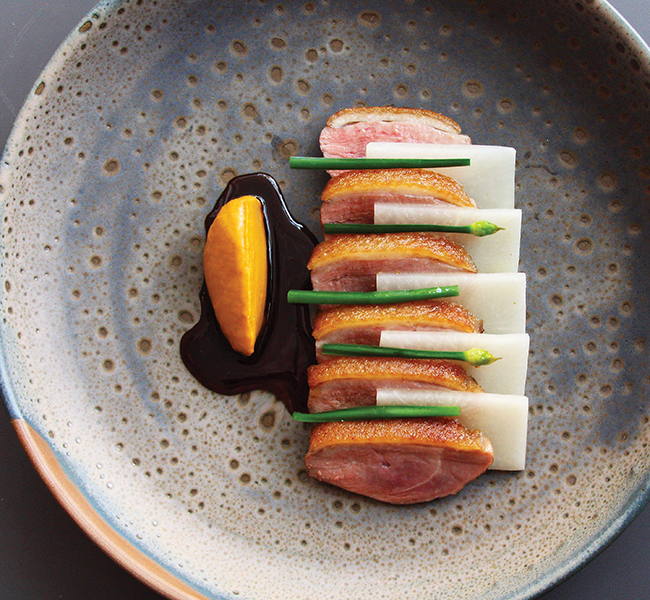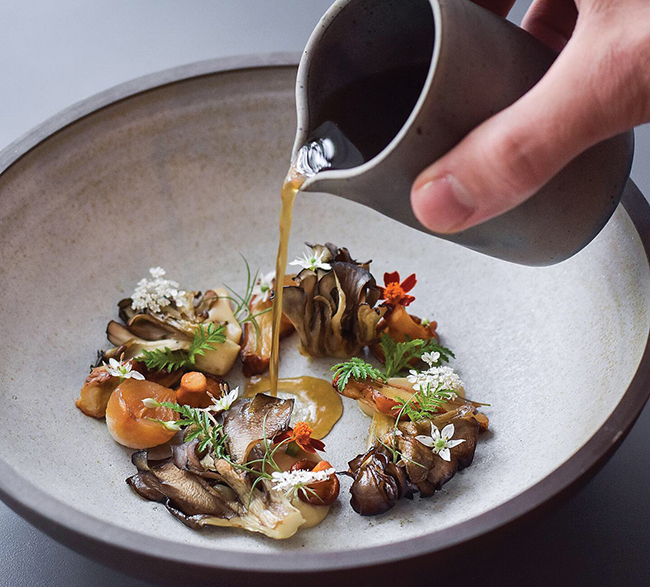The Art of Plating: How to Make Your Dishes Pop at Your Next Dinner Party

Photo: Victor Restaurant
At a recent event, I found myself riveted by the “tablescape” spread out before me. Part art installation, part sensory and wholly mesmerizing, it was design at the most inviting level. “Think about shapes and colour schemes you want to do,” I am told. This is not decor we’re talking about, however, as there was more to this table than just flatware and dishes. This is how you plate, according to chef Sean MacDonald, who has just opened Est, a tasting menu-based restaurant in east-end Toronto’s up-and-coming Riverside (neighbours include the hip Broadview Hotel and chef Lynn Crawford’s perennial favourite, Ruby Watchco). “Colour is a big factor in plating,” he adds. “Plate in a way that draws your eyes to different aspects and doesn’t leave your eye stuck in one place.”
Well, we do eat with our eyes, after all, and mine are hungry for more. What the chef actually means by the word plating is how exactly we place the food we are serving on the plate before it even arrives at table. Colours from the heirloom yellows of mini tomatoes sidling up to snippets of green garlic and mint to the hot fuchsia of a skinny shrimp cracker holding just a bite of red pepper salsa, the hues are popping, whetting my appetite even more. And this is just the amuse-bouche (a French term for nibbles to help get your taste buds ready for the main event, or course, in this case). Think of it as an aperitif but food rather than drink.

At Victor, the restaurant in the Hotel Le Germain Toronto, executive chef Lanny MacLeod offers this advice. “The key to plating is care and intent. Everything I put on a plate has a reason to be there; every element should add to the flavour or texture of the dish. When I present food, with either an architectural or rustic approach, I make sure that each item is placed on the plate with thought behind it.”
Start with the plate itself. “Circles are always the easiest,” he says. “Use the inner part of the circle or the centre of the plate as your guide.” Well, that I can do. “Or if you’re using platters, play to the shape.” If you’ve got a long or oblong serving dish, he says, try starting with your sauce or vinaigrette: “Take a paintbrush and just paint long strokes onto the platter,” he says, as he paints the white platter with swaths of green sauce. After the brush strokes, MacLeod takes his starting elements, in this case, three rounds of rösti topped with smoked salmon and arranges them unevenly along the strokes.
But like any artist, you’re only as good as your instruments. Key tools include squeeze bottles filled with everything from aïoli and chimichurri to maple syrup and balsamic vinaigrette to create perfect little globes of sauce for dipping, the aforementioned paintbrushes for creating a background and teaspoons for dolloping the extras. Edible flowers, bunches of sprouts and fresh herbs round out the flavours and the textures — and the eye candy appeal of a dish.

The easiest rule to follow? The rule of three, says MacLeod. Think three dots of mayo, three piles of smoked salmon, “layered over a swoosh of crème fraîche — think the Nike swoosh,” says MacLeod. Start by a teaspoon-sized dollop on the plate, then using the back of the spoon, “swoosh” the crème fraîche (or whatever sauce you’ve got — even ketchup could work, with little beef sliders) using the curve of your plate as a guide. The best part? “You can make really rustic dishes pop with the notion that it wasn’t just haphazardly thrown on a plate.” In other words, even something simple and rustic can have its moment in the spotlight, and no plate is perfect. Channel your inner artist. To borrow from the people that put the “swoosh” into our everyday lexicon, just do it.
A version of this article appeared in the November/December 2019 issue with the headline, “Feast,” p. 46-47.